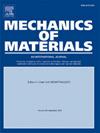Tailored energy dissipation with viscoelastic architectured materials
IF 3.4
3区 材料科学
Q2 MATERIALS SCIENCE, MULTIDISCIPLINARY
引用次数: 0
Abstract
A family of architectured materials (AMs) is studied for viscous damping. A computational methodology is employed to capture the energetic behavior of the AM. While the presented approach is generic for any symmetry class of AMs, the selected Representative Volume Elements (RVEs) have cubic symmetry. In particular, the set of truss structures including simple cubic, body-centered cubic and face-centered cubic and the set of Triply Periodic Minimal Surfaces (TPMS) including Gyroid, Diamond and Schoen IWP are analyzed. First, a homogenization method is implemented to extract the effective viscoelastic behavior of the chosen AMs, verified based on the correspondence principle. Second, the energetic behavior including the storage and loss factors are extracted for different anisotropy directions of the lattices. And finally, in order to showcase the application of such tailored energy response under a class of loadings, the energy dissipation of the homogenized models of the different RVEs are elaborated under hydrostatic, tensile and shear modes. Interestingly, for the same base material and the same relative density, the different AMs show different energy dissipation behavior in hydrostatic, tensile and shear modes. This opens up an excellent library of materials for a tailored energy dissipation.
粘弹性建筑材料量身定制的能量耗散
研究了一类具有粘性阻尼的建筑材料。采用一种计算方法来捕捉AM的能量行为。虽然所提出的方法是通用的任何对称类的AMs,所选择的代表性体积元(RVEs)具有立方对称性。重点分析了包括简单立方、体心立方和面心立方在内的桁架结构集以及包括Gyroid、Diamond和Schoen IWP在内的三周期极小曲面集。首先,采用均匀化方法提取所选AMs的有效粘弹性行为,并基于对应原理进行验证。其次,提取了晶格在不同各向异性方向上的能量行为,包括存储因子和损失因子;最后,为了展示这种定制化能量响应在一类载荷下的应用,详细阐述了不同rve的均质化模型在静力、拉伸和剪切模式下的能量耗散。有趣的是,对于相同的基材和相同的相对密度,不同的am在静力、拉伸和剪切模式下表现出不同的能量耗散行为。这为量身定制的能量耗散打开了一个优秀的材料库。
本文章由计算机程序翻译,如有差异,请以英文原文为准。
求助全文
约1分钟内获得全文
求助全文
来源期刊

Mechanics of Materials
工程技术-材料科学:综合
CiteScore
7.60
自引率
5.10%
发文量
243
审稿时长
46 days
期刊介绍:
Mechanics of Materials is a forum for original scientific research on the flow, fracture, and general constitutive behavior of geophysical, geotechnical and technological materials, with balanced coverage of advanced technological and natural materials, with balanced coverage of theoretical, experimental, and field investigations. Of special concern are macroscopic predictions based on microscopic models, identification of microscopic structures from limited overall macroscopic data, experimental and field results that lead to fundamental understanding of the behavior of materials, and coordinated experimental and analytical investigations that culminate in theories with predictive quality.
 求助内容:
求助内容: 应助结果提醒方式:
应助结果提醒方式:


